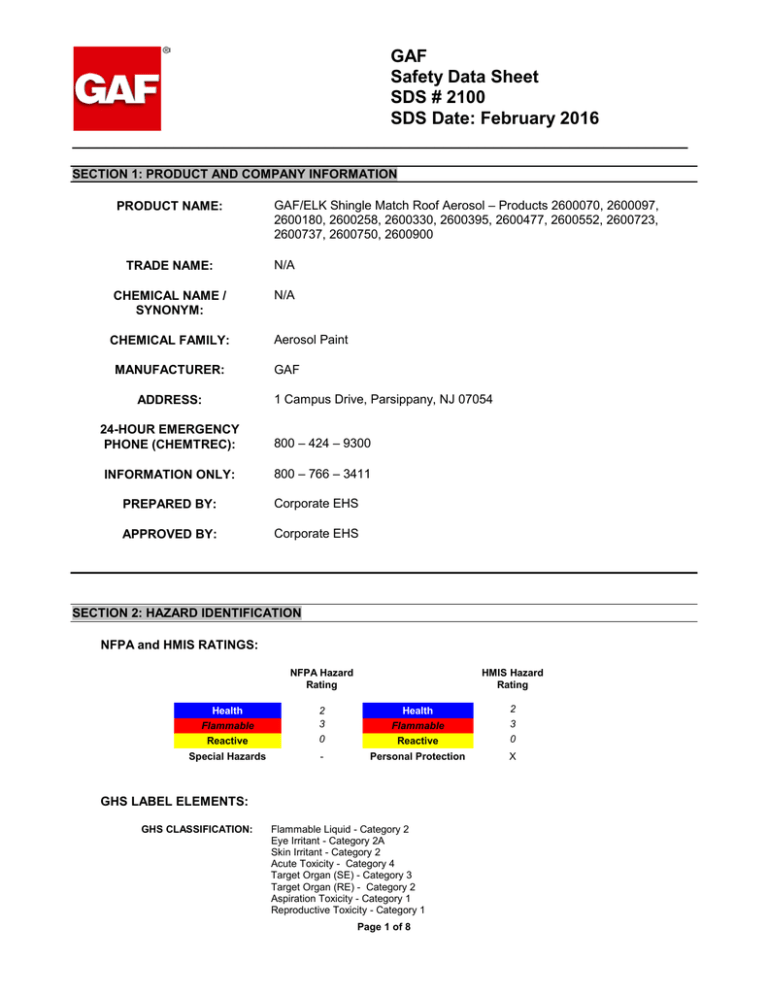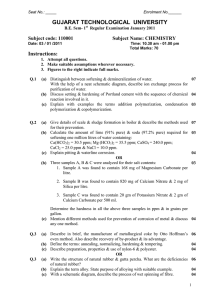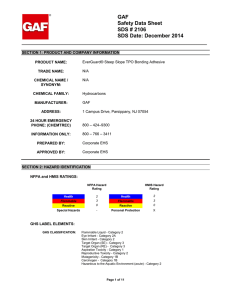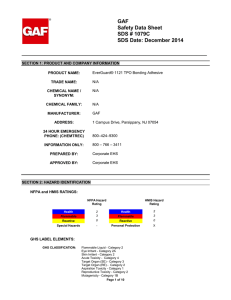GAF Safety Data Sheet SDS # 2100 SDS Date: February 2016
advertisement

GAF Safety Data Sheet SDS # 2100 SDS Date: February 2016 _________________________________________________________________________ SECTION 1: PRODUCT AND COMPANY INFORMATION PRODUCT NAME: GAF/ELK Shingle Match Roof Aerosol – Products 2600070, 2600097, 2600180, 2600258, 2600330, 2600395, 2600477, 2600552, 2600723, 2600737, 2600750, 2600900 TRADE NAME: N/A CHEMICAL NAME / SYNONYM: N/A CHEMICAL FAMILY: Aerosol Paint MANUFACTURER: GAF 1 Campus Drive, Parsippany, NJ 07054 ADDRESS: 24-HOUR EMERGENCY PHONE (CHEMTREC): 800 – 424 – 9300 INFORMATION ONLY: 800 – 766 – 3411 PREPARED BY: Corporate EHS APPROVED BY: Corporate EHS SECTION 2: HAZARD IDENTIFICATION NFPA and HMIS RATINGS: NFPA Hazard Rating HMIS Hazard Rating Health 2 Flammable Reactive 2 3 0 Flammable Reactive 3 0 Special Hazards - Personal Protection X Health GHS LABEL ELEMENTS: GHS CLASSIFICATION: Flammable Liquid - Category 2 Eye Irritant - Category 2A Skin Irritant - Category 2 Acute Toxicity - Category 4 Target Organ (SE) - Category 3 Target Organ (RE) - Category 2 Aspiration Toxicity - Category 1 Reproductive Toxicity - Category 1 Page 1 of 8 GAF SDS # 2100 Mutagenicity - Category 1B Carcinogen - Category 1B GHS PICTOGRAMS: SIGNAL WORD: HAZARD STATEMENTS: Danger Highly flammable liquid and vapor May cause damage to organs through prolonged or repeated exposure Repeated exposure may cause skin dryness and cracking Causes skin irritation Causes serious eye irritation May be fatal if swallowed May cause drossiness or dizziness Suspected of damaging fertility or the unborn child May cause genetic defects May cause cancer ADDITIONAL HAZARD IDENFITICATION INFORMATION: PRIMARY ROUTE OF EXPOSURE: Skin and inhalation SIGNS & SYMPTOMS OF EXPOSURE EYES: May cause irritation of the eyes including redness, stinging, and watering. SKIN: Exposure may cause mild irritation. Prolonged exposure may cause drying and cracking. INGESTION: Moderately toxic in large amounts. Could cause drowsiness, nausea or headache. INHALATION: Exposure to vapors, mists or sanding dusts may cause moderate irritation to the lungs, nose, and throat. May also cause dizziness, nausea or fatigue. ACUTE HEALTH HAZARDS: See above CHRONIC HEALTH HAZARDS: Reports have associated repeated and prolonged occupational exposure to solvents with permanent brain and nervous system damage. CARCINOGENICITY: This product contains carbon black and ethyl benzene. Ethyl benzene and carbon black have been classified by IARC as possible carcinogens (group 2B) for humans from lab animal studies. GAF SDS # 2100 SECTION 3: COMPOSITION/INFORMATION ON INGREDIENTS OCCUPATIONAL EXPOSURE LIMITS CHEMICAL NAME CAS # % (BY WT) OSHA ACGIH OTHER Acetone 67-64-1 30 – 33% 1000 ppm 500 ppm 750 ppm STEL REL: 250 ppm Propane/N-Butane Mixure 74-98-6 106-97-8 27 – 29% 1000 ppm/NE NE/800 ppm Toluene 108-88-3 13 – 16% 200 ppm 300 ppm – ceiling 20 ppm REL: 1000 ppm/1000 ppm STEL REL: 100 ppm 150 ppm STEL Ethyl Benzene 100-41-4 0 – 0.35% 100 ppm 125 ppm - ceiling 100 ppm Talc (containing no asbestos) 14807-96-6 4 – 6% 2 mg/m Carbon Black 1333-86-4 0 – 0.25% 20 mppcf (containing <1% Quartz) NE VM & P Naphtha 8030-30-6 8 – 10% Yellow Iron Oxide 51274-00-1 0 – 2% 3 REL: 100 ppm 125 ppm STEL REL: 2 mg/m3 – resp. 3.5 mg/m3 REL: 3.5 mg/m3 100 ppm 400 ppm REL: 400 mg/m3 NE NE NE NE = Not Established SECTION 4: FIRST AID MEASRURES FIRST AID PROCEDURES EYES: Immediately flush the eyes with large amounts of clean low-pressure water for at least 15 minutes, occasionally lifting the upper and lower lids. If symptoms persist, seek medical attention. SKIN: Remove contaminated clothing. Wash affected area with soap and water. Wash clothing before reuse. INHALATION: If overcome by exposure, remove victim to fresh air immediately. Give oxygen or artificial respiration as needed. Promptly obtain medical attention. INGESTION: Do not induce vomiting. Give 1 to 2 glasses of water to dilute. Promptly obtain medical attention. NOTES TO PHYSICIANS OR FIRST AID PROVIDERS: Pre-existing eye, skin, and respiratory disorders may be aggravated by exposure of this product. GAF SDS # 2100 SECTION 5: FIRE FIGHTING PROCEDURES SUITABLE EXTINGUISHING MEDIA: Carbon Dioxide, Dry Chemical, Foam, Water Fog HAZARDOUS COMBUSTION PRODUCTS: Carbon monoxide, carbon dioxide and unidentified organic compounds. RECOMMENDED FIRE FIGHTING PROCEDURES: Wear self-contained breathing apparatus and full protective clothing. Treat as a volatile liquid fire. Water may be unsuitable as an extinguishing medium. If water spray is used, fog nozzles are preferable. Water may be used to cool sealed containers to prevent pressure build-up and possible explosion or auto-ignition when exposed to the heat of a fire. UNUSUAL FIRE & EXPLOSION HAZARDS: Closed containers may explode when exposed to extreme heat. Isolate from heat, sparks, and open flame. Vapors may accumulate and travel to ignition sources distant from handling site. SECTION 6: ACCIDENTAL RELEASE MEASURES ACCIDENTAL RELEASE MEASURES: Eliminate all ignition sources. Contain spill, absorb liquid with clay, sand or floor absorbent. Prevent run-off to sewers, streams or other bodies of water. SECTION 7: HANDLING AND STORAGE HANDLING AND STORAGE: Handle as an extremely flammable material. Keep liquid and vapor away from heat, sparks, and open flame. Close container after each use. Store in a cool dry area. Do not expose container O to temperatures above 120 F. OTHER PRECAUTIONS: Keep out of reach of children. Intentional misuse by deliberately concentrating and inhaling contents may be harmful or fatal. SECTION 8: EXPOSURE CONTROLS/PERSONAL PROTECTION ENGINEERING CONTROLS / VENTILATION: Provide sufficient ventilation in volume and pattern to keep containments below applicable OSHA requirements or other suggested exposure limits. RESPIRATORY PROTECTION: Do not breathe vapors or mists. If the TLV, PEL, or other limits are exceeded, then wear a properly fitted vapor and particulate or positive pressure air supplied respirator approved by NIOSH/MSHA for use with paints during application and until all vapors and spray GAF SDS # 2100 mists are exhausted. Follow the respirator manufacturer’s directions for proper use. EYE PROTECTION: Safety glasses with side shields should be worn to prevent eye contact. Contact lens should not be worn. SKIN PROTECTION: Use solvent resistant gloves to avoid prolonged contact. OTHER PROTECTIVE EQUIPMENT: Eye washes and safety showers should be provided in the event of an accident. WORK HYGIENIC PRACTICES: Wash thoroughly after handling and before eating, drinking or smoking. EXPOSURE GUIDELINES: N/A SECTION 9: PHYSICAL AND CHEMICAL PROPERTIES APPEARANCE & ODOR: Colored liquid; solvent odor O FLASH POINT: < 20 F LOWER EXPLOSIVE LIMIT: 2% METHOD USED: No data UPPER EXPLOSIVE LIMIT: No data EVAPORATION RATE: Slower than Ether BOILING POINT: O <0 F GAF SDS # 2100 pH (undiluted product): No data MELTING POINT: SOLUBILITY IN WATER: No data SPECIFIC GRAVITY: Heavier than Air VAPOR DENSITY: No data 0.76 92 – 95% PERCENT VOLATILE: VAPOR PRESSURE: No data MOLECULAR WEIGHT: No data VOC WITH WATER (LBS/GAL): No data WITHOUT WATER (LBS/GAL): No data SECTION 10: STABILITY AND REACTIVITY THERMAL STABILITY: STABLE X UNSTABLE O CONDITIONS TO AVOID (STABILITY): Do not store above 120 F, incinerate, or puncture. INCOMPATIBILITY (MATERIAL TO AVOID): Avoid contact with strong oxidizing agents. HAZARDOUS DECOMPOSITION OR BYPRODUCTS: May emit fumes when heated to decomposition. May emit carbon monoxide, carbon dioxide, unidentified organic compounds. HAZARDOUS POLYMERIZATION: Will not occur. __________________________________________________________________________________________ SECTION 11: TOXICOLOGICAL INFORMATION TOXICOLOGICAL INFORMATION: No information available. SECTION 12: ECOLOGICAL INFORMATION ECOLOGICAL INFORMATION: No information available. __________________________________________________________________________________________ SECTION 13: DISPOSAL CONSIDERATIONS WASTE DISPOSAL METHOD: Dispose of containers and absorbed material in accordance with all federal, state, and local requirements. RCRA HAZARD CLASS: See above GAF SDS # 2100 SECTION 14: TRANSPORTATION INFORMATION U.S. DOT TRANSPORTATION PROPER SHIPPING NAME: This product is classified as a Consumer Commodity, ORM-D. HAZARD CLASS: N/A ID NUMBER: N/A PACKING GROUP: N/A LABEL STATEMENT: N/A OTHER: N/A SECTION 15: REGULATORY INFORMATION U.S. FEDERAL REGULATIONS TSCA: This product and its components are listed on the TSCA 8(b) inventory. CERCLA: N/A SARA 311/312 HAZARD CATEGORIES: Fire hazard, acute health hazard, chronic health hazard 313 REPORTABLE INGREDIENTS: Toluene, Ethyl Benzene CALIFORNIA PROPOSITION 65: This product contains chemicals known to the state of California to cause cancer and birth defects, or other reproductive harm. Other state regulations may apply. Check individual state requirements. The following components appear on one or more of the following state hazardous substances lists: Chemical Name CAS # CA MA MN NJ PA RI Acetone 67-64-1 No No No Yes No No Toluene 108-88-3 Yes Yes Yes Yes No Yes Propane 78-94-6 Yes Yes Yes Yes Yes Yes Ethyl Benzene 100-41-4 Yes Yes Yes Yes No Yes GAF SDS # 2100 Chemical Name CAS # CA MA MN NJ PA RI Hydrous Calcium Magnesium Silicate 14807-96-6 No No No No No No n-Butane 106-97-8 Yes Yes Yes Yes Yes Yes Carbon Black 13333-86-4 Yes No Yes No Yes Yes VM & P Naphtha 8030-30-6 Yes Yes Yes Yes Yes Yes Yellow Iron Oxide 51274-00-1 No No No No No No SECTION 16: OTHER INFORMATION ADDITIONAL COMMENTS: N/A DATE OF PREVIOUS SDS: December 2014 CHANGES SINCE PREVIOUS SDS: Replacement of generic propellant ingredient with propane/n-butane mixture. This information relates to the specific material designated and may not be valid for such material used on combination with any other materials or in any process. Such information is to the best of our knowledge and belief accurate and reliable as of the date compiled. However, no representation, warranty or guarantee, expressed or implied, is made as to its accuracy, reliability, or completeness. It is the user’s responsibility to satisfy himself as to the suitability and completeness of such information for his particular use. We do not accept liability for any loss or damage that may occur from the use of this information. Nothing herein shall be construed as a recommendation for uses which infringe valid patents or as extending a license of valid patents.







